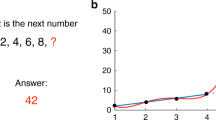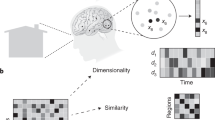Abstract
Sensory perception is a learned trait. The brain strategies we use to perceive the world are constantly modified by experience. With practice, we subconsciously become better at identifying familiar objects or distinguishing fine details in our environment. Current theoretical models simulate some properties of perceptual learning, but neglect the underlying cortical circuits. Future neural network models must incorporate the top-down alteration of cortical function by expectation or perceptual tasks. These newly found dynamic processes are challenging earlier views of static and feedforward processing of sensory information.
This is a preview of subscription content, access via your institution
Access options
Subscribe to this journal
Receive 51 print issues and online access
$199.00 per year
only $3.90 per issue
Buy this article
- Purchase on Springer Link
- Instant access to full article PDF
Prices may be subject to local taxes which are calculated during checkout




Similar content being viewed by others
References
Wang, Q., Cavanagh, P. & Green, M. Familiarity and pop-out in visual search. Percept. Psychophys. 56, 495–500 (1994).
Sigman, M. & Gilber, C. D. Learning to find a shape. Nature Neurosci. 3, 264–269 (2000).
Hertz, J., Krogh, A. & Palmer, R. G. Introduction to the Theory of Neural Computation (Perseus Publishing, Cambridge, Massachussetts, 1991).
Zhaoping, L., Herzog, M. & Dayan, P. Nonlinear observation and recurrent preprocessing in perceptual learning. Network 14, 233–247 (2003).
Poggio, T., Fahle, M. & Edelman, S. Fast perceptual learning in visual hyperacuity. Science 256, 1018–1021 (1992).
Herzog, M. H. & Fahle, M. The role of feedback in learning a vernier discrimination task. Vision Res. 37, 2133–2141 (1997).
Adini, Y., Sagi, D. & Tsodyks, M. Context enabled learning in human visual system. Nature 415, 790–794 (2003).
Tsodyks, M., Adini, Y. & Sagi, D. Associative learning in early vision. Neural Netw. 17, 823–832 (2004).
Wilson, H. R. & Cowan, J. D. Excitatory and inhibitory interactions in localized populations of model neurons. Biophys J. 12, 1–24 (1972).
Hoshino, O. Neuronal bases of perceptual learning revealed by a synaptic balance scheme. Neural Comput. 16, 563–594 (2004).
Teich, A. & Qian, N. Learning and adaptation in a recurrent model of V1 orientation selectivity. J. Neurophysiol. 89, 2086–2100 (2003).
Schoups, A., Vogels, R., Qian, N. & Orban, G. Practising orientation identification improves orientation coding in V1 neurons. Nature 412, 549–553 (2001).
Ben-Yishai, R., Bar-Or, R. L. & Sompolinsky, H. Theory of orientation tuning in visual cortex. Proc. Natl Acad. Sci. USA 92, 3844–3848 (1995).
Douglas, R., Koch, C., Mahowald, M., Martin, K. & Suarez, H. Recurrent excitation in neocortical circuits. Science 269, 981–985 (1995).
Somers, D., Nelson, S. & Sur, M. An emergent model of orientation selectivity in cat visual cortical simple cells. J. Neurosci. 15, 5448–5465 (1995).
Gilbert, C. D. & Wiesel, T. N. The influence of contextual stimuli on the orientation selectivity of cells in primary visual cortex of the cat. Vision Res. 30, 1689–1701 (1990).
Dragoi, V., Sharma, J. & Sur, M. Adaptation-induced plasticity of orientation tuning in adult visual cortex. Neuron 28, 287–298 (2000).
Polat, U. & Sagi, D. Spatial interactions in human vision: from near to far via experience-dependent cascade of connections. Proc. Natl Acad. Sci. USA 91, 1206–1209 (1994).
Seung, H. S. Learning in spiking neural networks by reinforcement of stochastic synaptic transmission. Neuron 40, 1063–1073 (2003).
Williams, R. Simple statistical gradient-following algorithms for connectionst reinforcement learning. Mach. Learn. 8, 229–256 (1992).
Crist, R. E., Kapadia, M., Westheimer, G. & Gilbert, C. D. Perceptual learning of spatial localization: specificity for orientation, position and context. J. Neurophysiol. 78, 2889–2894 (1997).
McKee, S. P. & Westheimer, G. Improvement in vernier acuity with practice. Percept. Psychophys. 24, 258–262 (1978).
Polat, U., Ma-Naim, T., Belkin, M. & Sagi, D. Improving vision in adult amblyopia by perceptual learning. Proc. Natl Acad. Sci. USA 101, 6692–6697 (2004).
Ullman, S. & Bart, E. Recognition invariance obtained by extended and invariant features. Neural Netw. 17, 833–848 (2004).
Crist, R., Li, W. & Gilbert, C. Learning to see: experience and attention in primary visual cortex. Nature Neurosci. 4, 519–525 (2001).
Li, W., Piech, V. & Gilber, C. D. Perceptual learning and top-down influences in primary visual cortex. Nature Neurosci. 7, 651–657 (2004).
Recanzone, G. H., Merzenich, M. M. & Jenkins, W. M. Frequency discrimination training engaging a restricted skin surface results in an emergence of a cutaneous response zone in cortical area 3a. J. Neurophysiol. 67, 1057–1070 (1992).
Recanzone, G. H., Schreiner, C. E. & Merzenich, M. M. Plasticity in the frequency representation of primary auditory cortex following discrimination training in adult owl monkeys. J. Neurosci. 13, 87–103 (1993).
Recanzone, G. H., Merzenich, M. M. & Schreiner, C. E. Changes in the distributed temporal response properties of SI cortical neurons reflect improvements in performance on a temporally based tactile discrimination task. J. Neurophysiol. 67, 1071–1091 (1992).
Bakin, J. S. & Winberger, N. M. Induction of a physiological memory in the cerebral cortex by stimulation of the nuclear basalis. Proc. Natl Acad. Sci. USA 93, 11219–11224 (1996).
Kilgard, M. P. & Merzenich, M. M. Cortical map reorganization enabled by nucleus basalis activity. Science 279, 1714–1718 (1998).
Seung, H. S., Sompolinsky, H. & Tishby, N. Statistical mechanics of learning from examples. Phys. Rev. A 45, 6056–6091 (1992).
Herzog, M. H. & Fahle, M. Modeling perceptual learning difficulties and how they can be overcome. Biol. Cybern. 78, 107–117 (1998).
Mato, G. & Sompolinsky, H. Neural network models of perceptual learning of angle discrimination. Neural Comput. 8, 270–299 (1996).
Dosher, B. A. & Lu, Z. L. Perceptual learning reflects external noise filtering and internal noise reduction through channel reweighting. Proc. Natl Acad. Sci. USA 95, 13988–13993 (1998).
Moses, Y., Schechtman, G. & Ullman, S. Self-calibrated collinearity detector. Biol. Cybern. 63, 463–475 (1990).
Weiss, Y., Edelman, S. & Fahle, M. Models of perceputal learning in vernier hyperacuity. Neural Comput. 5, 695–718 (1993).
Karni, A. & Sagi, D. The time course of learning a visual skill. Nature 365, 250–252 (1993).
Ahissar, M. & Hochstein, S. Attentional control of early perceptual learning. Proc. Natl Acad. Sci. USA 90, 5718–5722 (1993).
Watanabe, T., Nanez, J. E. & Sasaki, Y. Perceptual learning without perception. Nature 413, 844–848 (2001).
Seitz, A. R. & Watanabe, T. Psychophysics: is subliminal learning really passive? Nature 422, 36 (2003).
Rao, R. P. & Ballard, D. H. Dynamic model of visual recognition predicts neural response properties in the visual cortex. Neural Comput. 9, 721–763 (1997).
Ullman, S. Sequence seeking and counter streams: a computational model for bidirectional information flow in the visual cortex. Cereb. Cortex 5, 1–11 (1995).
Hebb, D. O. Organization of Behavior (John Wiley & Sons Inc, 1949).
Barlow, H. B. & Foldiak, P. in The Computing Neuron (eds Durbin, R. Miall, C. & Mitchison, G.) 54–72 (Addison-Wesley, Workingham, England, 1989).
Markram, H., Lubke, J., Frotscher, M. & Sakmann, B. Regulation of synaptic efficacy by coincidence of postsynaptic Aps and EPSPs. Science 275, 213–215 (1997).
Senn, W., Markram, H. & Tsodyks, M. An algorithm for modifying neurotransmitter release probability based on pre- and post-synaptic spike timing. Neural Comput. 13, 35–67 (2001).
Yu, C., Levi, D. M. & Klein, S. A. Perceptual learning in contrast discrimination and the (minimal) role of context. J. Vision 4, 169–182 (2004).
Adini, Y., Wilkonsky, A., Haspel, R., Tsodyks, M. & Sagi, D. Perceptual learning in contrast discrimination: the effect of contrast uncertainty. J. Vision, in the press.
Ghose, G. M., Yang, T. & Maunsell, J. H. R. Physiological correlates of perceptual learning in monkey V1 and V2. J. Neurophysiol. 87, 1867–1888 (2002).
Acknowledgements
We thank W. Li, V. Piech, D. Sagi and K. Pawelzik for their suggestions on the manuscript. M.T. is supported by Israeli Science Foundation and Irving B. Harris foundation. C.G. is supported by NIH.
Author information
Authors and Affiliations
Ethics declarations
Competing interests
The authors declare no competing financial interests.
Rights and permissions
About this article
Cite this article
Tsodyks, M., Gilbert, C. Neural networks and perceptual learning. Nature 431, 775–781 (2004). https://doi.org/10.1038/nature03013
Published:
Issue Date:
DOI: https://doi.org/10.1038/nature03013
This article is cited by
-
Artificial Intelligence Meets Flexible Sensors: Emerging Smart Flexible Sensing Systems Driven by Machine Learning and Artificial Synapses
Nano-Micro Letters (2024)
-
Perceptual learning based on a temporal stimulus enhances visual function in adult amblyopic subjects
Scientific Reports (2023)
-
Reconstruction of sparse recurrent connectivity and inputs from the nonlinear dynamics of neuronal networks
Journal of Computational Neuroscience (2023)
-
Memristive Artificial Synapses for Neuromorphic Computing
Nano-Micro Letters (2021)
-
Cue-triggered activity replay in human early visual cortex
Science China Life Sciences (2021)
Comments
By submitting a comment you agree to abide by our Terms and Community Guidelines. If you find something abusive or that does not comply with our terms or guidelines please flag it as inappropriate.



